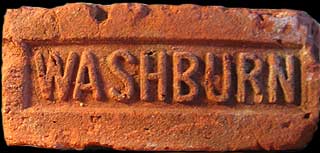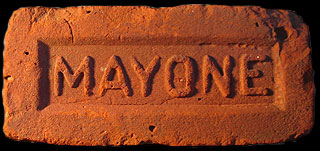"The Gentleman from Ulster"
Since moving to Glasco (New York), Joseph Mayone had his
eyes on the brick manufacturers. After all, the Hudson River clay was plentiful, the
waterway provided the route to deliver bricks to the fastest growing city and brick
market in the world - New York City. And, if the Cordt's and the Hutton's could do it,
why couldn't an Italian?
 Joseph arrived home after a long but successful day to his Villa Regina. Yes, it
really was his own Villa, built just as he had envisioned with the Italian architecture
and style imitating and even named after the villa of his birthplace in Italy that he
had admired so much. Every time he drove up the driveway, he couldn't help but smile at
the sight of his beloved Villa.
Joseph arrived home after a long but successful day to his Villa Regina. Yes, it
really was his own Villa, built just as he had envisioned with the Italian architecture
and style imitating and even named after the villa of his birthplace in Italy that he
had admired so much. Every time he drove up the driveway, he couldn't help but smile at
the sight of his beloved Villa.
He pulled into the six car garage. While just one of many buildings built with Mayone
bricks these days, this edifice was obviously more special to him than the others.
His business plans were working out just as he had planned. He had entered the brick
manufacturing business by leasing a brickyard in Portersville, just south of Glasco.
His successful management of the business had earned him enough money to build a
brickyard in Athens, in 1910.
The business conditions were ripe for success. Waves of immigrants needed housing and
the New Tenement Act of 1901 and other New York City building regulations had required
the use of fire retardant brick materials. The 1906 tragic collapse of the downriver
Haverstraw plant and its town due to a landslide caused by the clay pit excavation had
created more demand for the upriver manufacturers and had provided excavation safety
lessons for future manufacturers.
Joseph had visited the Villa site just about every day during its construction in 1913
and 1914. He had a routine, whereby he would tend to the day's business in the
brickyards, stop by his hotel in Catskill on the corner of Water and Church Streets,
and visit the Villa, making sure that every brick was being placed exactly according to
the architectural plans.
"Joseph, why are you using Washburn bricks to build this house?" many asked.
But those who knew him well understood his frugality. G. W. Washburn bricks were used
for the main house instead of the Mayone brick because it was cheaper to transport the
Washburn brick from Glasco than to use his own bricks produced in Athens.
Joseph was generous, but he expected nothing less than hard work and dedication from
those who worked or borrowed from him. He often extended credit to local workers at
his store in Glasco, many of whom paid up their accounts by working on his new house.
Immigrants themselves, Joseph's workers both admired and envied him. He was, on one
hand, just like them having made his way in the New World. But, most of these laborers
accepted that they would never own a villa like the one that they toiled on day after
day. They couldn't understand why - they could only hope for future generations and
sneak a couple of bricks in their lunch pails.

"Giovanni, do you know why Signore Mayone has the biggest house?" one worker would ask
another. "Because he has the biggest lunch pail," they would joke and rationalize
Joseph's fortune.
Lunch pail in hand, Joseph entered the house calling out, "Buona sera! We must celebrate!"
They gathered around the dinner table. Roland, the latest addition to the family,
squealed like only a three year old can. Charles and John were doing their best not to
spoil their father's news, having been at the brickyard when it was announced.
Raising his wine glass, Joseph declared, "I would like to make a toast to the Mayone
Brick Company, officially incorporated in Glasco today!"
At age 50, Joseph Mayone had it all.
"The Mayone Brick Company took possession July 1, 1925, of the Freeman property, West
Bridge street (Powder Spring Farm), formerly owned by Frederick Cooke. This company
operates yards at Athens and Glasco," the local newspaper reported. Joseph put down
the paper, knowing that it was only part of the story - he still had plans for
expansion and would six years later own his Catskill brickyard.
"Good day, Saverio,"
Joseph greeted Saverio Barone on the street on the way to the Athens National Bank,
where he had recently been named a Director and was a principle shareholder. Joseph's
son John was the bank president.
"A good day to you, sir," Saverio returned the
greeting with the utmost respect and admiration for this man who was a generation older
than him and a figurehead in the community.
The last few years had been good for
Joseph's business and therefore his status within community. His businesses had
managed to survive the brief but severe 1920-1921 depression brought on by World War I
hyperinflation, a Federal reserve interest rate hike, and 12% unemployment that had
caused a drop in brick prices and production. Now his business was booming. The New
York metropolitan area was experiencing a building craze as people flocked to new
neighborhoods in the outer boroughs and suburbs. In 1923, the price of brick commanded
$20 per 1000.
During these boom times, it was hard for Joseph Mayone or his fellow
manufacturers to imagine that just 5 years later, the price per 1000 would drop to $12
and that by 1933 it would fall to $9.50. By 1927, almost fifty percent of the 130
Hudson brick yards that existed 20 years previously would be out of business.
With his sons Eddie and Charles having re-located to Westchester County, and with all
of the NY metropolitan business coming his way, Joseph made frequent trips and even
kept a brickyard office in New York City on 125th Street, the Mayone name visible on
the door.
"Great news!" exclaimed Joseph to Charles Sr. "We've received a very large
order!" "It's just what you need Papa," said Charles. He meant the comment not only
because of his Father's state of his business, but after the passing of his Mother, he
worried about his Father. Not to mention the recent crash of the stock market. These
were dark days indeed.
"But you know that I fear the future of brick manufacturing,"
Charles continued on. "You know that these concrete block manufacturers are not going
away, not to mention these cheap Belgian bricks they are importing these days. And of
course, someday the clay will be gone. But, tell me about the order."
"These two crazy
automotive guys, Walter Chrysler of Chrysler Corp. and John Jakob Raskob, who is the
creator of General Motors, have entered a contest to see who can build the tallest
building," Joseph explained. "We are going to be one of many Hudson River
manufacturers to supply the 10 million bricks they need to build this new New York
skyscraper."
"Ah, yes, the Empire State Building project," acknowledged Charles. "Yeah,
it seems crazy. They want to build 102 stories in just over a year. They say it will
take 2,500 - 4,000 men at least seven million man-hours!" exclaimed Joseph.
(Ed. Note: On January 22, 1930, excavation began on the Empire State Building.)
Working in the Catskill plant one day, Joseph's attention quickly turned to some unwelcome
visitors. A bunch of mob union goons had stormed the plant in an attempt to enlist new
union members.
"Get off my property or I will blow your heads off!" Joseph shouted with
shotgun in hand, pointing it directly at the intruders. The mob never messed with
Joseph again. Joseph earned a reputation of respect.
Joseph often attended brick manufacturing association meetings in New York City.
Joseph brought Charles Sr. to one particular meeting.
"Good day gentlemen," Joseph confidently addressed his fellow Upriver manufactures and
the larger Downriver manufacturers. Besides the fact that out of some 300 Hudson River
Valley manufacturers he was the only Italian manufacturer, his presence, being over six
feet tall and impeccably dressed in his black 3-piece suit, was duly noted.
There had been a time when the Upriver manufacturers could and did undercut the
Downriver manufacturers. But as an astute businessman, Joseph saw the power of a
collective voice. In prior meetings he had agreed to abide by the price guidelines.
And, he was a man of his word.
As the meeting discussion progressed, Joseph became agitated.
"Bang - Bang - Bang!" rang out Joseph's cane on the table as he rose.
"You all have violated the price guidelines! I will do things my own way from now on!"
With that, he stormed out to the embarrassment of his son, Charles.
Charles Mayone Sr.
had moved to Larchmont and was himself becoming a prominent businessman as the
President of the Building National Supply Company. In addition to two Larchmont homes,
Mayone bricks were used in many apartment buildings in the Bronx and Westchester. A
particular notable apartment building at 30 Clinton Place in New Rochelle was
considered modern in its day at six stories with balconies, sunken living rooms, an
incinerator, and a spacious lobby. In addition, he built six stores in Greenwich, CT
on the Boston Post Road., the same road where in Larchmont he would build his last
structure, the Larchmont Motel, which he managed in his later years."



 Joseph arrived home after a long but successful day to his Villa Regina. Yes, it
really was his own Villa, built just as he had envisioned with the Italian architecture
and style imitating and even named after the villa of his birthplace in Italy that he
had admired so much. Every time he drove up the driveway, he couldn't help but smile at
the sight of his beloved Villa.
Joseph arrived home after a long but successful day to his Villa Regina. Yes, it
really was his own Villa, built just as he had envisioned with the Italian architecture
and style imitating and even named after the villa of his birthplace in Italy that he
had admired so much. Every time he drove up the driveway, he couldn't help but smile at
the sight of his beloved Villa.
